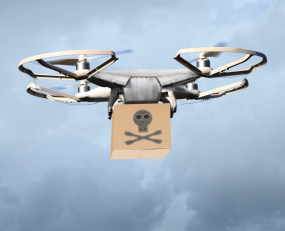
The realm of delivery services has taken flight, quite literally, with the advent of drone technology. These unmanned aerial vehicles, once confined to military, have soared into the commercial domain, revolutionising the logistics landscape and promising swift, efficient, and innovative delivery solutions.
In recent years, the deployment of drones for delivery purposes has gained substantial momentum across the globe. From urban metropolises to remote rural communities, companies have been experimenting with and implementing drone delivery services, aiming to streamline logistics and redefine the concept of “fast delivery.”
One of the key driving forces behind the surge in drone delivery is the need for rapid and convenient shipping methods. Drones offer the potential to bypass traditional road-based transportation, avoiding traffic congestion and significantly reducing delivery times. This speed advantage is particularly crucial in industries such as e-commerce, where customers increasingly demand quicker turnaround times.
Several pioneering companies have leaped into the drone delivery arena. Industry giants like Amazon, UPS, and DHL have conducted extensive trials and pilot programs, testing the feasibility and efficiency of drone delivery in various terrains and weather conditions.
Amazon Prime Air, for instance, has been diligently working on its drone delivery service, envisioning small, unmanned aircraft zipping through the skies to deliver packages to customers within 30 minutes of order placement.
Similarly, UPS Flight Forward has made significant strides in the United States, securing the first full approval for a drone airline from the Federal Aviation Administration (FAA), allowing the company to expand drone delivery services beyond mere testing phases.
According to a report by Future Market Insights, the industry is set for substantial expansion, foreseeing substantial growth in the global drone delivery service market. The report suggests that by 2033, this market could surge to a valuation of US$ 7,217.4 million, a remarkable leap from its 2023 valuation of US$ 426.1 million.
Despite the promising potential, the widespread implementation of drone delivery faces hurdles. Regulatory concerns, airspace management, safety protocols, and public acceptance are critical factors that require careful navigation. Privacy concerns and potential disruptions to air traffic necessitate robust regulatory frameworks and technological advancements to ensure safe and seamless integration of drones into airspace.
While the adoption of drone delivery varies across regions due to regulatory disparities and technological readiness, many countries are actively exploring and embracing this disruptive technology.
In China, drone delivery services have been rapidly expanding, with companies like JD.com and Alibaba’s Ele.me exploring innovative ways to deliver goods to customers’ doorsteps using drones.
European countries, including the United Kingdom, have been actively testing and developing drone delivery networks, collaborating with regulatory bodies to establish guidelines for safe and efficient operations.
Drone delivery represents a paradigm shift in the logistics industry, offering a glimpse into a future where the skies become a new frontier for swift and efficient delivery services. As technology advances and regulatory frameworks evolve, the global landscape of drone delivery is poised to continue its upward trajectory, revolutionising the way goods are transported and delivered across the world.
Supply chain strategists can use GSCi – Ti’s online data platform – to identify opportunities for growth, support strategic decisions, help them stay abreast of industry trends and development, as well as understand future impacts on the industry.
Visit GSCI subscription to sign up today or contact Michael Clover for a free demonstration: [email protected] | +44 (0) 1666 519907